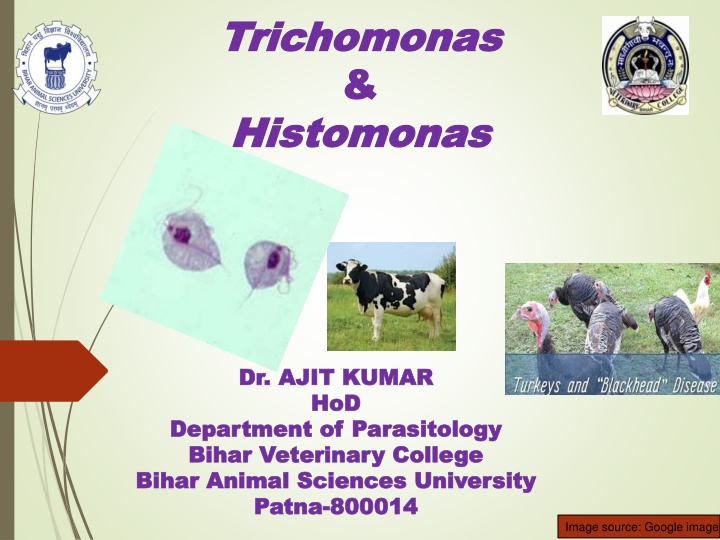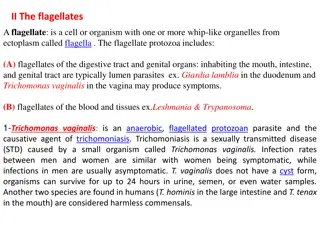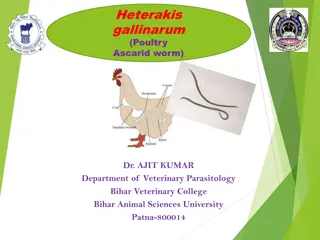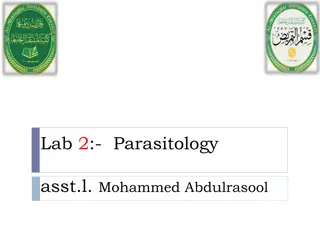
Overview of Tritrichomonas foetus: Morphology, Hosts, and Transmission
Learn about Tritrichomonas foetus, a pathogenic parasite mainly affecting cattle but also found in other animals. Explore its morphology, hosts, transmission methods, and more. Discover how this parasite is transmitted, its impact on cattle breeding, and measures for control and prevention.
Download Presentation

Please find below an Image/Link to download the presentation.
The content on the website is provided AS IS for your information and personal use only. It may not be sold, licensed, or shared on other websites without obtaining consent from the author. If you encounter any issues during the download, it is possible that the publisher has removed the file from their server.
You are allowed to download the files provided on this website for personal or commercial use, subject to the condition that they are used lawfully. All files are the property of their respective owners.
The content on the website is provided AS IS for your information and personal use only. It may not be sold, licensed, or shared on other websites without obtaining consent from the author.
E N D
Presentation Transcript
Trichomonas Trichomonas & & Histomonas Histomonas Bihar Animal Sciences University | Dr. AJIT KUMAR Dr. AJIT KUMAR HoD HoD Department of Department of Parasitology Bihar Veterinary College Bihar Veterinary College Bihar Animal Sciences University Bihar Animal Sciences University Patna Patna- -800014 800014 Parasitology Image source: Google image
Family : Family : Trichomonidae Trichomonidae o Parasites trichomonads. commonly called o Usually found in digestive tract or some of the organisms may also present in the reproductive tract. o Body is pyriform shaped with rounded anterior end and pointed posterior ends. o Parasites have 3-5 flagella, undulating membrane, axostyle uninucleated. , costa and Image source: Google image
Family : Family : Trichomonidae Trichomonidae Genus and Genus and Species Species Tritrichomonas foetus Host Host Location Location Cattle, buffalo, pig, horse etc. Reproductive tract Trichomonas gallinae Pigeon, turkeys etc. Upper digestive tract Trichomonas vaginalis Man Vagina and urethra
Tritrichomonas Tritrichomonas foetus foetus Morphological characters :- Body is usually pear shaped. It has three anterior flagella and a posterior flagellum that runs along the undulating membrane and then continues as a free flagellum. A hyaline rod like structure known as axostyle which run through the midline of the cell and emerges posteriorly. It has characteristic vigorous jerky movement. Multiplication by longitudinal binary fission. Sexual multiplication or cyst formation absent. Image source: Google image
Tritrichomonas Tritrichomonas foetus foetus Host : It is mainly pathogenic in cattle but may also occur in buffalo, horse, pig and deer. Location: vagina and uterus in cow whereas preputial cavity in bull. Image source: Google image
Tritrichomonas Tritrichomonas foetus foetus Transmission: o Organisms mainly transmitted through coitus o During gynecological examination, the parasites may transmitted. o Bulls, once permanent source of infection whereas in cows, the infection parasites may gradually disappear. Artificial insemination and infected, remain a is self-limiting and Image source: Google image
Transmission of T. foetus Image source: Google image
Tritrichomonas Tritrichomonas foetus foetus Pathogenesis: oIt causes the specific bovine bovine trichomonosis trichomonosis or bovine abortion abortion in in cattle cattle. specific venereal bovine trichomonad venereal disease trichomonad disease, Cows: o Vaginitis, endometritis, placentitis with detachment of the placental membranes and death of the foetus which lead to an early abortion usually 8-16 weeks after the infected service.
Tritrichomonas Tritrichomonas foetus foetus Pathogenesis: Cows: o Sometimes foetus and foetal membrane retained leading to purulent endometritis. o When cervix is closed and corpus luteum is retained, then closed pyometra develops and uterus may contains several liters of greyish-white fluid swarming with trichomonads, which will give the appearance of pregnancy. o In long standing case, the trichomonads may disappear from the uterine fluid so disappear is self-limiting in cows.
Tritrichomonas Tritrichomonas foetus foetus Pathogenesis: Bulls: o Small red nodules in the mucous membrane. o Mucopurulent discharge from the preputial cavity. o Above signs disappeared from 1-2 weeks after the infection. o Spontaneous recovery is are and bulls remain permanently infected
Tritrichomonas Tritrichomonas foetus foetus Symptoms: Cows: oEarly conception). o Vaginal discharge, mucopurulent endometritis, anestrous, irregular hear period. abortion(usually 8-16 weeks after Bulls : o Pain during micturition, disinclination to serve cows and preputial discharge.
Early Abortion due to T. foetus Image source: Google image
Tritrichomonas Tritrichomonas foetus foetus Diagnosis: history failure of conception, increase vaginal discharge and incidence of pyometra in the herd etc.). Herd (early abortion, Microscopic examination of vaginal discharge or washing, uterine discharge, preputial discharge, stomach contents of aborted foetus, amniotic fluids etc. reveled T. foetus with characteristic vigorous jerky movement. Serological agglutination ands skin test` test like cervical mucus Image source: Google image
Tritrichomonas Tritrichomonas foetus foetus Treatment: oSince the infection in self-limiting in cows, infected animals should be given breeding rest to cure the infection. o Use of Acriflavin ointment in infected bull with the help of pudendal anesthesia. o Berenil or Dimetridazole is also used in the treatment
Tritrichomonas Tritrichomonas foetus foetus control: Infected bulls must be either castrated or slaughtered. Avoid breeding between susceptible cow and infected bull and vice versa. Aborted cows should be given breeding rest for three consecutive estrous periods.
Trichomonas Trichomonas gallinae gallinae Host : Pigeons , turkey and chicken. Location: Upper digestive tract o Organism has only four anterior flagella. o Organism transmitted from adult pigeons to their offsprings through infected pigeons crop milk. o Adults pigeons cat as carrier but nestling pigeons (squabs) are highly susceptible. o It causes yellow necrotic lesions (yellow buttons) in the mouth, oesophagus, crop and proventriculus.
Family: Monocercomonadide Histomonas meleagridis Morphology Morphology : :- - o Organisms (pleomorphic) with a single nucleus and single flagellum. o Four Four stages stages of of parasites been been recognized recognized : :- - are amoeboid parasites have have I. I. II. II. Invasive Invasive stage, Vegetative Vegetative stage, stage, stage, III. III. Resistant Resistant stage stage and stage. . and IV. IV. flagellar flagellar stage Image source: Google image
Histomonas meleagridis o Host : Turkey (mainly) but also in chicken, pheasant, partridge and quail. o Location : Caecal mucosa and liver parenchyma o Reproduction :- By binary fission Image source: Google image
Histomonas meleagridis Mode of Transmission: Transmission takes place in birds by ingestion of embryonated eggs of the caecal worm (Heterakis containing Histomonas organism. gallinarum) meleagridis Infection of birds may also occur by the ingestion of earthworm which is transport host for Heterakis eggs and larvae.
Histomonas meleagridis Pathogenesis :- Histomonosis yellowish caseous plug in caecum and formed circular necrotic depressed centre (bulls eye appearance) in liver. produces exudates foul smelling a hard forming foci with yellow Circular necrotic lesions Circular necrotic lesion s in caecum Image source: Google image
Histomonas meleagridis o It caused diseases is called Histomonosis Infectious Infectious enterohepatitis enterohepatitis or in in turkey turkey. o Symptoms: o Sulphur Sulphur yellow yellow coloured coloured faeces turkeys which is not common sign in chicken. o A few turkeys shows cyanotic discoloration of the skin of the head and wattles from which black head name arises but it is not a constant feature of the disease. Histomonosis or or Black Black head head disease or disease faeces especially in
Histomonas meleagridis On the basis of symptoms like Sulphur yellow yellow coloured coloured faeces faeces etc Sulphur etc. . Characteristic Characteristic necrotic in in caecum caecum and examination examination. necrotic lesions and liver liver lesions found during during P P. .M found M. .
Treatment of Histomonas meleagridis Furazolidone, Dimetridazole, Nithiazide and 2-amino 5- nitrothiozole drugs are used in treatment.
Control of Histomonas meleagridis o Adoption of hygienic measures, o Avoiding overcrowding and prevent contamination of feed and drinking water with droppings, o separate rearing of different species of birds.




